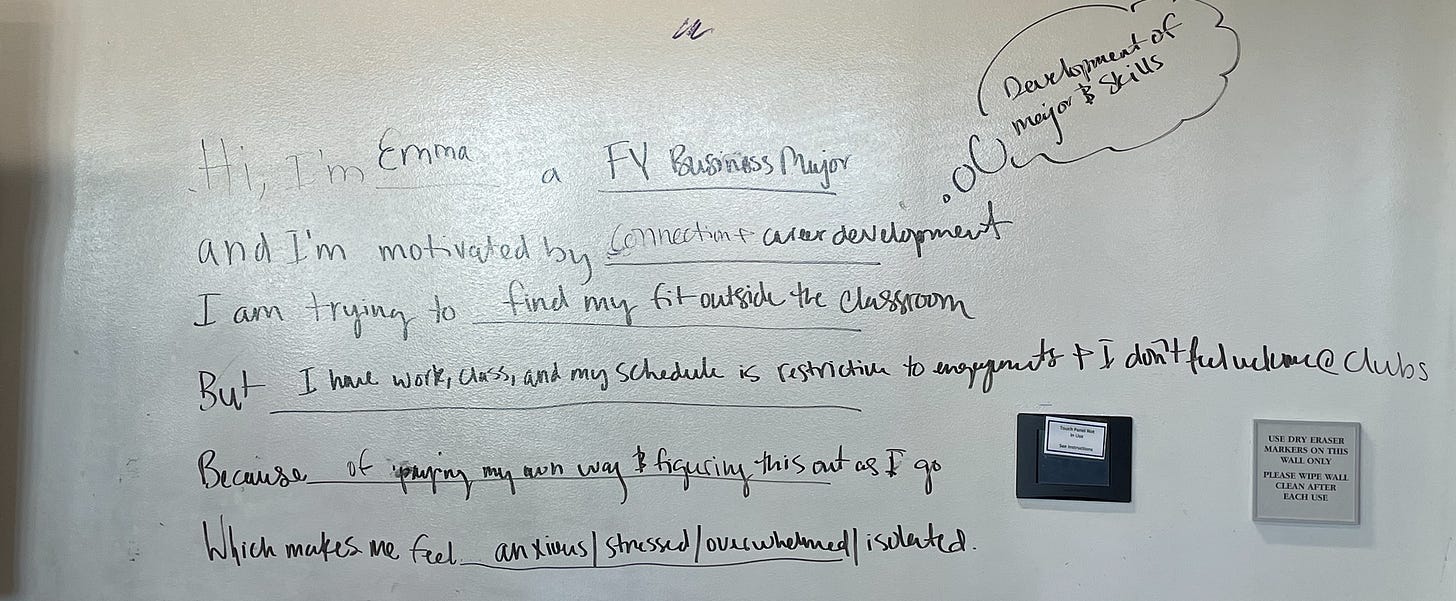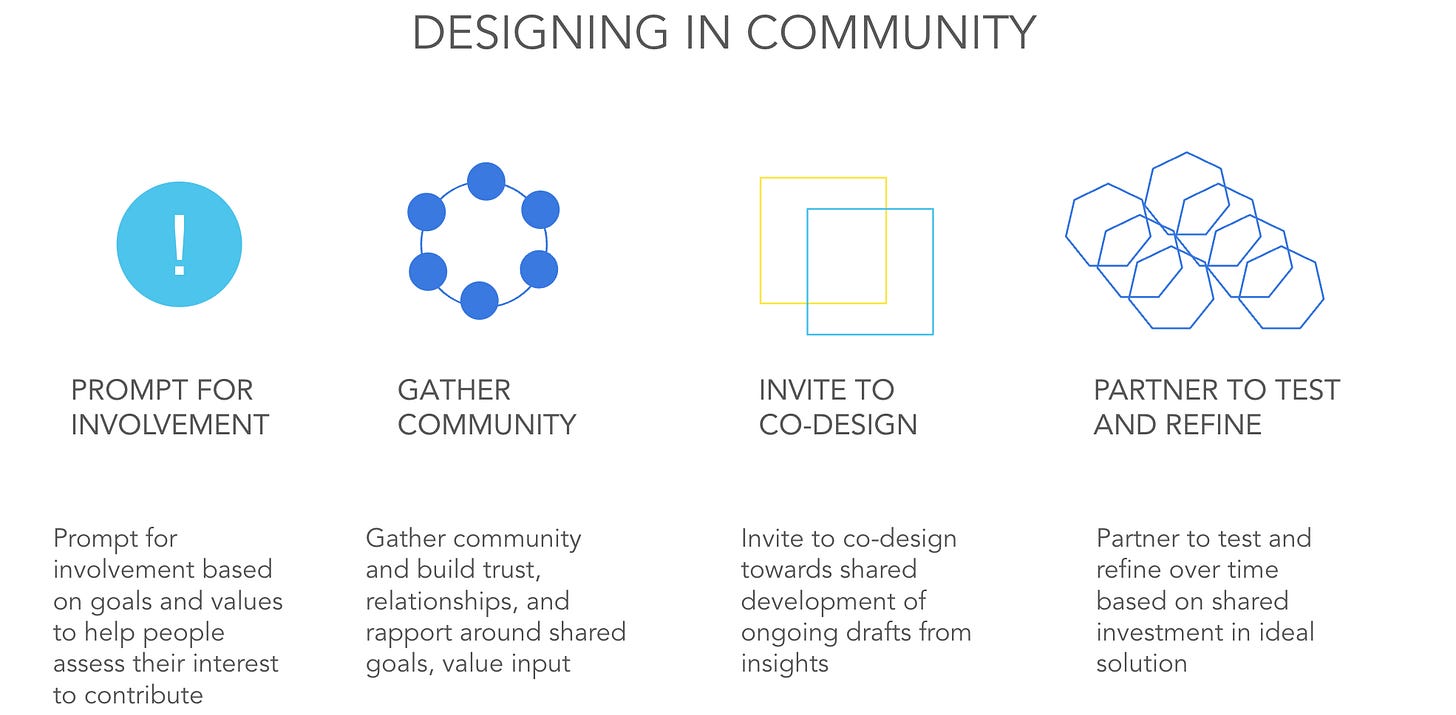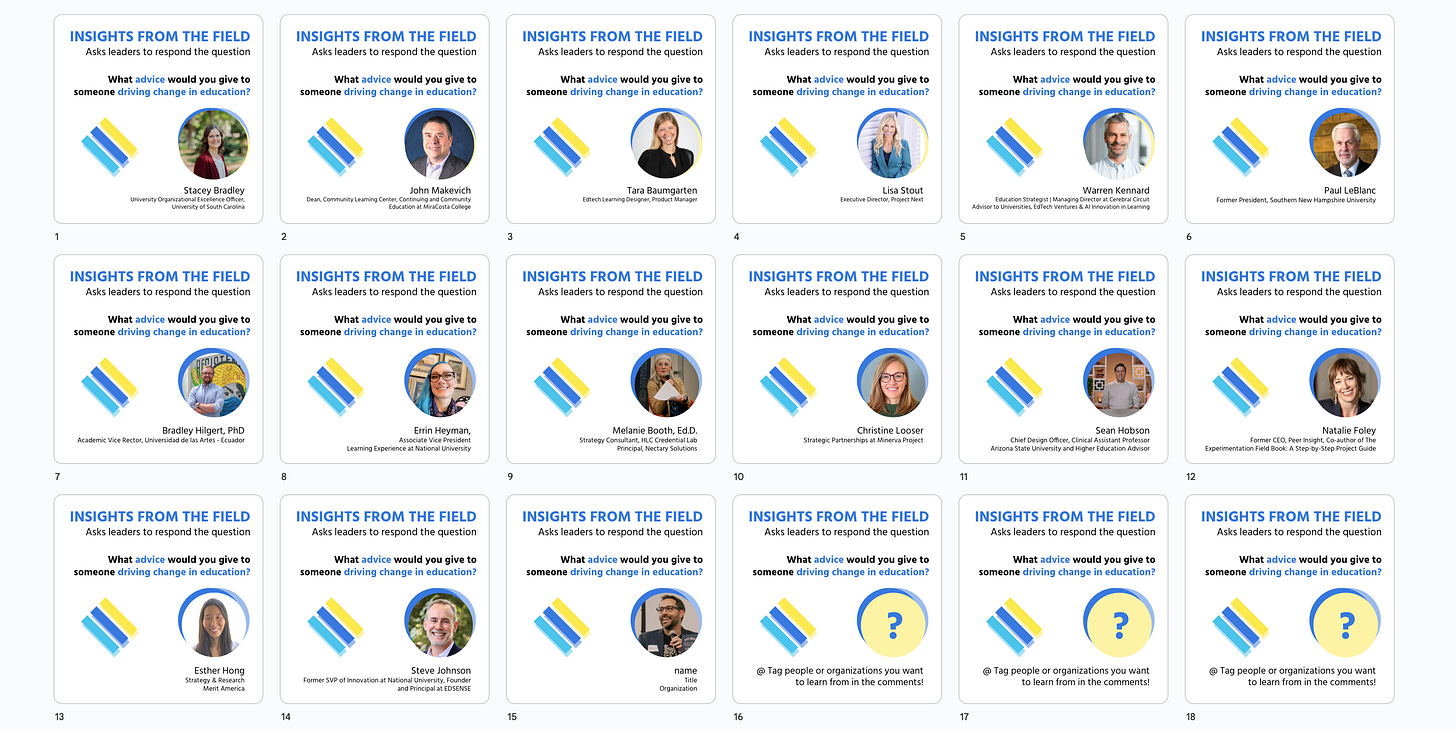Design is catalyzing action
A designers role in driving investment, engagement, and momentum
👋 Hi, thanks for reading. For those who celebrated the long weekend, I hope your week is off to a great start!
I’m writing because education wasn't designed around students but we can improve the learner experience through design. I share stories, tips, and work in progress weekly.
I sent this week’s newsletter a bit later than normal. What do you think?
Thanks for your feedback. Back to this weeks post!
Why it matters: Design is change. To drive change it takes a balance of people, technology, and process and engaging the head, the heart, and the hands. Designers think about the tactical work and the progress through this change process using design tools and methods. Below is a snapshot of my latest work and efforts or organize, build investment, engage, and grow momentum.
Go deeper:
At Intuit, employees trained in the internal design tools (“Design for Delight”) were called Innovation Catalysts. I’ve always taken that role of “designer as catalyst” to heart.
Catalyst: Someone or something that encourages progress or change.
Roles of the designer as catalyst
In launching new projects and beginning to organize stakeholders and accelerate momentum, my role is as a catalyst. At the onset of a project this may look like:
helping build clarity on the focus of our work
designing events with impact
gathering people around moments to learn, explore, create, plan, and respond
offering structures for people invested in influencing change to engage with
In the last several weeks it’s meant:
ideating with campus partners for potential employers to engage with
learning about the current state of our project topic
nudging campus partners for information: data, programs, outcomes, and their own experiences and programs.
But to maximize the human-centered design process, I believe one of the most important catalyzing efforts a designer can have is bringing teams closer to the people they are designing “for,” inviting a more collaborative “with.”
But this doesn’t happen all at once, and often it requires new mindsets and ways of working.
The magic of talking to people
After a week onsite with a partner institution leading employer events and a design sprint, I’m reminded once again: there is magic in bringing stories, especially challenges, to life directly through people experiencing them.
When people hear a students’ experience with the challenges they face today first-hand, those learning about them become invested in making-meaning of them and working to solve them.
To initiate connection around someone’s problem is to light a spark of passion to pursue solving it. I share this quote from Mr. Rogers during design sprints right before I send teams into the field to interview as a bit of preparation for the magic they’re about to encounter:
But stories and connection can’t be where the effort ends. Stories build connection, but catalysts turn that into action.

Investment = Engagement = Momentum
The most powerful thing I can do as a designer is to help harness that investment in people and their problems (asking ‘what’s the problem?’) to build engagement in our continued work together (asking ‘how can I help?’) and accelerating momentum towards a solution built alongside those affected (saying ‘let’s try that approach together’).
In the last few weeks we’ve turned local employers into invested advocates for students by hearing success stories as well as challenges yet to be overcome. Now we’ll interview them to learn more about their needs, expectations, and perceptions.
We’ve turned project team members into collaborators shaping the curiosity of areas requiring more research and offering data, connections, and resources needed to drive impact. Now we’ll invite them into research, meaning-making, and co-creation alongside key stakeholders.
Importantly, we’ve motivated leaders to endorse and advocate on the importance of this work and encourage others to participate. Now we’ll give them the materials to spread the needs, goals, and importance of this work.
Orchestrating and harnessing progress
Initiating and motivating action is important, but sustaining that engagement and momentum is critical to success. The design process offers the map and the guideposts that guide progress, but the interventions provided by designers are what harness and sustain the energy required to gather and bring changes to life.
It’s well-organized structures, clear milestones, and thoughtfully timed moments that help drive insights into action.
Over the next several weeks we’ll begin diving into interviews with stakeholders and invite the project team, employers, students, faculty, and other stakeholders into the process.
And by helping the group “get curious” and build empathy, they’ll deepen their connection to the work, the progress, and the outcome. By starting with the people behind the problem the team will connect with who they can impact, and we’ll spend the summer figuring out how alongside them.
Insights from the Field - Need a student to bring this to life!
I’m taking a commercial break from this week’s feature for a request for students who you think can bring to life this series in a standalone digital experience.
One of my goals for 2025 is turning my weekly “Insights from the Field” from the Learning, Designed newsletter into a compelling, interesting, and inspiring "gallery" of advice for higher education leaders.
I've been asking college presidents, executive design leaders, edtech pros, and educators for advice on driving change in education: ~150-300 words of guidance with no fluff.
I'm hoping to create a digital space from the advice I’m collecting that aligns to the Learning, Designed brand and can offer an interactive source of inspiration for education leaders.
This is a living, growing project so while I'm looking for compelling design, I'm also looking for a space that's functionally straightforward to maintain and grow. It can be a new build or cleverly utilizing existing builder tools as long as it meets our criteria.
I'm always willing to be a strong, positive reference for people I think do great work. This is work I'm willing to invest in (financially and professionally) for a student that can help accomplish these goals.
I'm looking for a design / UX / computer science undergraduate college student interested in developing a piece for their digital portfolio as project work with me over this summer.
If you know the perfect student, know someone who might, or are one of them yourself, reach out!
Learning is better when it’s social.
If this post moved something in you, tap the ❤️, pass it along, or join the conversation on LinkedIn—I’d love to hear what it sparked.




